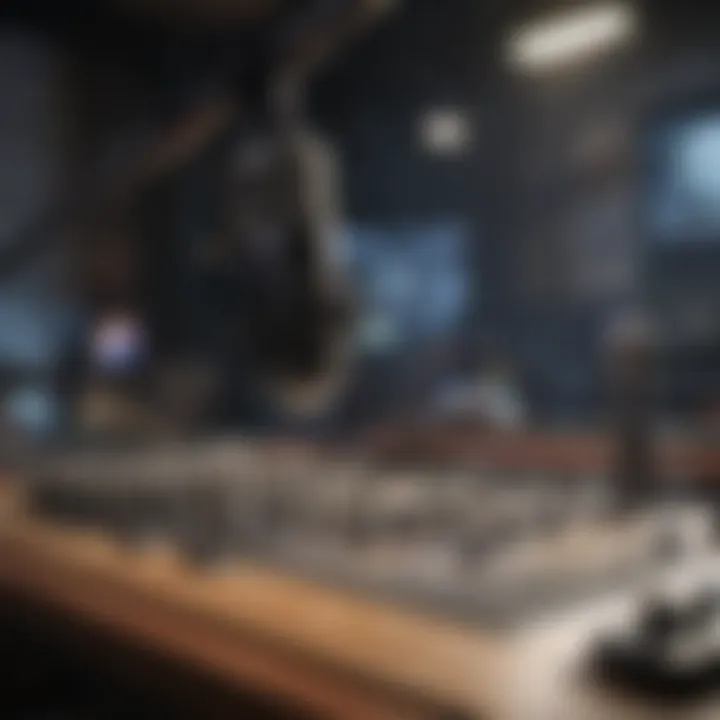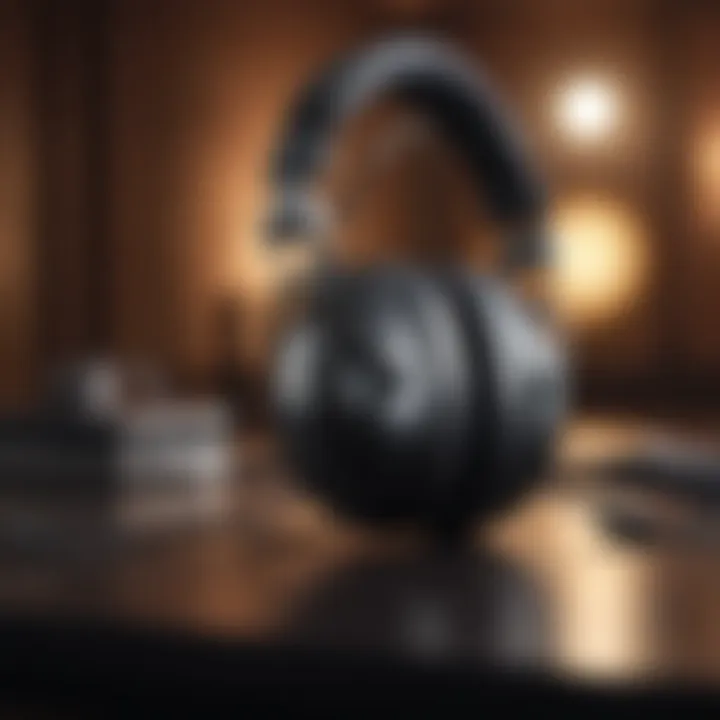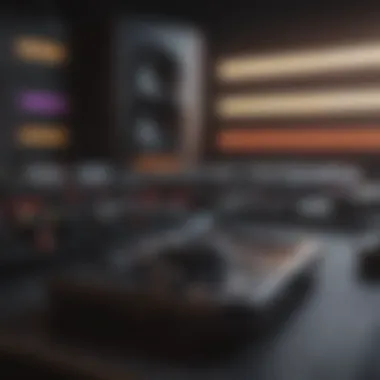Mastering Music: Record Your Song on iPhone


Intro
Recording a song on your iPhone has become increasingly popular for both amateurs and professionals. The iPhone offers a portable solution that allows musicians to create high-quality audio without the need for sophisticated equipment. With various apps available, along with robust in-built features, users can capture their creativity on the go.
In this article, we will explore essential steps required to record a song on your iPhone effectively. From the preparation stages to detailed guidance on tools and techniques, this guide aims to equip you with the knowledge necessary to produce quality audio.
Product Overview
To begin, let’s briefly discuss what makes the iPhone a suitable device for recording music. The latest models, such as the iPhone 12 and iPhone 13, come equipped with enhanced microphones and powerful processors. This ensures superior audio capture and editing capabilities.
Key Features
- A14 and A15 Bionic Chips: These processors provide the power needed for audio applications, enabling quick processing of sound files.
- High-Quality Microphones: The built-in stereo microphones effectively capture clear audio, essential for music recording.
- Large Storage Options: With storage variants ranging from 64GB to 512GB, there's ample space for storing recordings.
Available Variants/Colors
The iPhone comes in diverse colors, including Black, White, Red, Green, and Blue. This variety appeals to different aesthetic preferences, adding a personal touch to the device that contributes to user experience.
Design and Build Quality
The design of the iPhone has always stressed functionality along with style. Its sleek profile and lightweight nature make it easy to hold during recording sessions. The materials used in construction promote durability without compromising on aesthetics.
The iPhone's glass back and aluminum edges not only contribute to a premium feel but also help in better signal reception. Overall, the build quality is impressive, which enhances user confidence when recording in various environments.
Performance and User Experience
The performance of iPhones in handling audio applications has garnered high praise. The A14 and A15 Bionic chips ensure that even complex audio tasks can be managed smoothly.
User Interface
The iOS experience is streamlined, making it easy for users to navigate through apps. Built-in applications like GarageBand simplify the recording process. You can expect a responsive interface that caters to both beginners and seasoned musicians.
Additionally, multitasking capabilities allow users to switch between music apps and social media seamlessly, which is essential for sharing and collaborating.
Camera and Media Capabilities
While the iPhone is well known for its camera capabilities, its audio features are equally impressive.
Audio Quality
The audio generated from the iPhone’s microphone is remarkable. Users can record in various formats, which enhances flexibility in post-production.
While recording, it is crucial to pay attention to environmental noise. Ideally, you should choose a quiet location or use external microphones for better results.
Media Consumption Experience
Listening to your recordings can be just as enjoyable as creating them. The iPhone delivers a rich audio experience through its speakers and connects with high-quality headphones.
Pricing and Availability
The pricing of the iPhone varies based on the model and storage capacity. While it is generally considered a premium device, its features justify the cost, especially for those serious about music recording.
Availability


The iPhone is widely available across various regions. Retailers like Apple Store and authorized resellers ensure that users can easily purchase the device.
When comparing the iPhone to competitors, such as Samsung Galaxy series, the iPhone often offers better integration with audio apps, making it a more attractive option for those focused on music.
The End
Recording a song on your iPhone opens up a world of creative possibilities. With an understanding of the device’s capabilities and the right techniques, you can produce impressive audio tracks. This guide will help you navigate each aspect of the recording process, allowing for a smooth musical journey.
Understanding the Capabilities of Your iPhone for Music Recording
Recording a song on your iPhone calls for a grasp of its capabilities. The device is far more than a communication tool; it is an effective digital audio workstation. Understanding what your iPhone offers can transform your music recording process.
The iPhone's performance, combined with its portability, provides immense potential for musicians. Features include high-quality audio codecs and various recording applications. These capabilities allow you to capture your musical ideas on-the-go. Knowing the strengths and limitations of your device is essential. You want to make an informed decision on which tools and techniques will yield the best results.
Audio Quality Considerations
Audio quality stands out as a fundamental aspect of music production. It directly impacts how your message and artistry resonate with listeners. iPhones have made considerable advancements in audio technology, yet it is important to be aware of the factors influencing sound quality.
- Sample Rate: Higher sample rates enhance audio clarity. Most music professionals prefer 44.1kHz or higher.
- Bit Depth: A larger bit depth ensures a more dynamic range.
- Environment: The acoustics of your recording space affect the sound.
In standard recording apps, these settings can sometimes be adjusted. If you aim to produce high-quality tracks, pay attention to these considerations during the recording process.
Microphone Types and Specifications
Microphones play a crucial role in determining sound quality. The type of microphone used can drastically alter how well you capture audio. The iPhone’s built-in microphone is adequate for many purposes, but understanding external options will open new avenues for improved sound.
- Dynamic Microphones: Good for loud sound sources and live settings. They capture sound well without overwhelming distortion.
- Condenser Microphones: More sensitive and better suited for capturing vocals and intricate details in instruments. They usually require additional power.
- Lavalier Microphones: Ideal for interviews or capturing spoken word. They offer discreet recording options.
An awareness of these microphone types will allow you to choose the best fit for your specific recording needs.
Preparing Your Environment
Setting up a suitable environment is crucial for achieving high-quality recordings on your iPhone. The space where you choose to record will significantly impact the audio clarity and overall sound quality. Proper preparation can help eliminate unwanted noise, enhance sound fidelity, and ensure a smooth workflow during the recording process. This section elucidates the essential aspects of preparing your environment to foster a productive recording experience.
Choosing the Right Location
Selecting the right location for recording may seem straightforward, but it demands careful consideration. Ideally, a quiet place minimizes distractions and ambient sounds. Rooms with soft furnishings tend to absorb sound better, reducing echo and reverberation. A dedicated space, devoid of significant noise sources, provides an optimal setting for capturing clear audio.
For instance, basements or attics can serve as good recording locations, as these areas usually have less foot traffic and external noise. Experimenting with several spots can reveal the best acoustic environment for your specific needs. Take time to walk around and listen to how your voice or instruments sound in different locations.
Minimizing Background Noise
Background noise can be a recording artist's greatest foe. Recognizing potential sources is the first step to minimizing interference. Common culprits include HVAC systems, traffic, and electronic devices. To combat these issues:
- Shut windows and doors to limit external sounds.
- Turn off appliances that produce noise, such as fans or refrigerators.
- Use carpets and curtains to absorb sound vibrations.
- Avoid recording during peak hours if outside noise is a concern.
By taking these measures, you significantly enhance sound quality. Effective noise reduction leads to clearer recordings, culminating in a more polished final product.
Setting Up Your Recording Space
Once you have determined your location and eliminated as much noise as possible, it is essential to organize your recording space. An efficient setup can increase your focus and streamline the recording process. Here are a few key considerations for setting up:
- Positioning: Arrange your instruments and equipment conveniently. You should have easy access to your iPhone, audio interfaces, or any other recording gear.
- Lighting: Good lighting helps enhance your mood. Ensure your space isn't too dim, which may hinder your creativity.
- Comfort: Use supportive seating to help with long recording sessions. Ensuring comfort can help maintain focus.
In summary, the effort you put into preparing your environment directly influences the quality of your recordings. Taking the time to choose the right location, minimize background noise, and organize your space will yield noticeable improvements in your audio output. Ultimately, this preparation sets the foundation for a successful recording session, allowing you to focus entirely on your music.


Overview of Recording Tools Available
Recording music on your iPhone requires an understanding of the tools available to achieve high-quality results. The tools you choose can greatly impact your recording experience and the final output. Recording tools range from native applications that come pre-installed on your device to more advanced third-party options and external hardware.
By gaining insight into these options, you will be better prepared to navigate the recording landscape, making informed decisions that align with your musical vision. The right tools can enhance your creativity and streamline the entire recording process.
Native iPhone Recording Apps
The iPhone comes equipped with several native apps that are designed for recording audio efficiently. Primarily, the Voice Memos app serves as a straightforward solution for capturing quick ideas or demos. It is user-friendly and allows basic editing options like trimming audio.
Another notable app is GarageBand, which transforms your iPhone into a versatile studio. It offers a broad range of features including multi-track recording, virtual instruments, and loops. Users can layer vocals and instruments seamlessly. GarageBand is quite popular for its intuitive interface and extensive capabilities that cater both to beginners and experienced musicians.
Third-Party Music Production Apps
While native apps serve well for basic recordings, third-party music production apps can elevate your production quality. Apps like FL Studio Mobile, Cubasis, and KORG Gadget provide advanced features such as MIDI editing, audio effects, and sophisticated mixing capabilities.
These apps often offer subscription models or one-time purchases, providing a range of functionalities that adapt to different skill levels and recording needs. Investing time in exploring various third-party options can lead you to discover tools that best fit your recording style.
Audio Interfaces and External Microphones
For those serious about their music, investing in audio interfaces and external microphones can significantly improve sound quality. Brands like Focusrite and IK Multimedia offer portable audio interfaces that connect seamlessly with your iPhone. This helps in managing multiple inputs, such as guitars and keyboards, with professional-grade clarity.
Furthermore, upgrading to an external microphone, such as the Shure MV5 or Rode VideoMic Me, can capture sound more accurately than the built-in mic. These microphones can enhance the detail and richness of your recordings and are usually compact, making them convenient for on-the-go setups.
The Recording Process
The recording process is a critical phase in creating music on your iPhone. This step transforms your ideas into tangible audio. The ability to record effectively lays the foundation for a successful song. Thus, understanding the intricacies involved in recording is essential for anyone serious about music production. This section will cover setting up your recording app, inputting instruments and vocals, and effective recording techniques.
Setting Up Your Recording App
To start, you must select and set up your recording app. Make sure you choose a reputable app that suits your needs. Popular options include GarageBand and Ferrite Recording Studio. Each app has its own interface. Familiarize yourself with the features and settings. Here are key steps for setting up your app:
- Download and install your chosen app from the App Store.
- Open the app and create a new project.
- Adjust your project settings, such as sample rate and bit depth, to optimize sound quality.
- Ensure your device's microphone settings are configured correctly. Check if the app is listening to your internal microphone or an external one.
Taking these steps ensures your recording will be high quality right from the start.
Inputting Instruments and Vocals
Next, you must input the instruments and vocals that will define your track. This can be done through direct recording or MIDI input. Each method has its own advantages. Direct recording captures the unique qualities of acoustic instruments and vocals. MIDI input, however, allows flexibility in editing and layering sounds. Here are some tips for both methods:
- For direct recording:
- For MIDI input:
- Use a good quality microphone. This can significantly affect audio fidelity.
- Position the microphone correctly to capture vocals or instruments effectively.
- Perform multiple takes if necessary. This gives you options to choose the best recording.
- Use a MIDI controller connected to your iPhone. This enables you to play virtual instruments within the app.
- Explore various sound libraries available in the app to find the right sounds.
- Record in sections to maintain accuracy and focus on complex parts easily.
Utilizing the right techniques during this stage will elevate the quality of your song.
Recording Techniques and Best Practices
Finally, employing effective recording techniques and adhering to best practices is vital. These methods can shape the overall outcome of your final product. Here are some recommended practices:
- Use a metronome: Keeping a steady beat is essential for maintaining rhythm throughout your recording.
- Monitor your levels: Pay attention to input levels. This ensures you avoid clipping or distortion in your audio.
- Record in a quiet environment: Silence reduces the chance of unwanted noise infiltrating your recording.
- Stay relaxed and focused: Anxiety can hinder performance. Take breaks if you feel overwhelmed.
"Successful recording lies half in the technology and half in the attitude of the artist."


By incorporating these techniques, you increase the likelihood of producing a polished final track. Each aspect discussed here plays a vital role in the overall recording process. With proper application of these tools and techniques, recording on your iPhone can be both effective and enjoyable.
Post-Production Steps
Post-production is critical in music recording. It is the stage where raw audio transforms into a polished piece ready for listening. This phase holds significance for both the recording quality and the overall impact of the song. The right post-production techniques can elevate the listener's experience and enhance the song's marketability. Here, we will explore the essential steps involved in post-production, focusing on editing, mixing, mastering, and exporting your recording.
Editing Your Recorded Track
Editing is the first step in post-production. It involves refining the initial recordings to improve clarity and coherence. During this phase, you can remove unwanted noise, adjust timings, and cut or trim segments that do not fit well. It is crucial to pay attention to the details. For example, listen for areas with background interference or flaws that detract from the main performance.
Consider using apps like GarageBand or Logic Pro on your iPhone for detailed editing tasks. These apps allow you to manipulate waveforms easily. The key aspects to consider during editing include:
- Noise Reduction: Eliminate background sounds that might distract the listener.
- Crossfades: Smooth transitions between clips to avoid abrupt changes in audio.
- Time Alignment: Ensure that different tracks align properly to create a unified sound.
Mixing and Mastering Basics
Mixing and mastering are separate but interconnected processes. Mixing refers to blending individual audio tracks together to create a balanced sound. Mastering is about preparing and transferring the recorded mix into a final format ready for distribution.
In mixing, you should pay attention to levels, equalization, and effects:
- Levels: Adjust the volume of each track so that no part is overpowering. Ensure vocals sit well with instrumentation.
- Equalization (EQ): This is adjusting frequency levels to help each instrument and vocal find its place in the mix. For instance, reducing certain frequencies may reduce muddiness in the sound.
- Effects: Adding reverb or delay can enhance depth but must be used judiciously to avoid cluttering the overall sound.
Mastering typically involves final adjustments to ensure consistent levels across all playback systems. This process might require equalization and compression to maintain a professional sound quality across varying formats.
Exporting Your Song
After finalizing your mix and mastering, the next step is exporting your song. This is the process of rendering your project into a single, playable audio file. Most music production apps on the iPhone offer straightforward exporting options.
Considerations for exporting include:
- File Format: WAV and MP3 are the standard formats. WAV is lossless and provides high quality while MP3 is compressed and ideal for reducing file size.
- Bit Rate: A higher bit rate usually leads to better sound quality. For general use, a bit rate of 192 kbps or higher works well for MP3s.
- Metadata: Adding tags like artist name, album, and track information helps in organizing and presenting your music.
Final Considerations
Recording music on your iPhone is a journey that combines creativity with technical skills. As you reach the final steps of this process, it is essential to understand the final considerations that will enhance your overall experience and the end result of your song. This section highlights specific elements, their benefits, and important aspects regarding your recorded music.
Understanding the Rights to Your Music
When you create music, you gain ownership of that work. This ownership includes the right to control how it is used and shared. Understanding your rights is crucial before you publish or share your song.
Music copyright grants you exclusive rights to reproduce, distribute, and perform your work publically. In the United States, as soon as you create a song and fix it in a tangible medium (which can include a digital format on your iPhone), you automatically gain copyright protection. However, registration with the U.S. Copyright Office provides additional legal benefits, especially if you find yourself in a dispute regarding ownership.
Benefits of Understanding Your Rights:
- Control Over Distribution: You dictate how, where, and when your music is shared.
- Financial Compensation: If others use your music, you can earn licensing fees.
- Protection Against Theft: Documenting your rights helps if your music is used without permission.
Make sure to keep detailed records of your music creation process. This includes demo recordings, lyric sheets, and drafts, which can be useful if ownership issues arise in the future.
Sharing Your Music with the World
Sharing your music can be both exciting and nerve-wracking. Once you feel ready to present your song, consider the various platforms and methods for distribution. Today, you have many options available, whether traditional or digital.
Some effective ways to share your music include:
- Social Media Platforms: Consider using platforms like Facebook, Instagram, and TikTok to reach a broader audience. Create engaging posts to showcase your music, perhaps through short clips or behind-the-scenes content.
- Music Streaming Services: Upload your song to platforms such as Spotify, Apple Music, or SoundCloud. These services provide a global reach. Using tools like DistroKid or TuneCore could simplify the process of getting your music on these platforms.
- Personal Website or Blog: Having your own online space allows you to control how your music is presented and heard. Consider integrating a blog for updates and insights on your creative process.
- Live Performances: Consider hosting small gigs or open mic sets. This can be a great way to test your song in front of an audience, gaining direct feedback.
"The act of sharing transforms music from a personal endeavor into a communal experience."
Sharing your music also opens doors for collaboration with other artists. It fosters relationships that could enhance your creative output. Remember that promoting your music is vital. Engage with your audience, respond to feedback, and build a connection. This will help create a loyal fanbase willing to support your future projects.
Ultimately, considering your rights and effectively sharing your work can significantly impact your success as a musician. Combine these aspects with creativity and the tools available through your iPhone, and you have the power to take your music further than you might have imagined.















